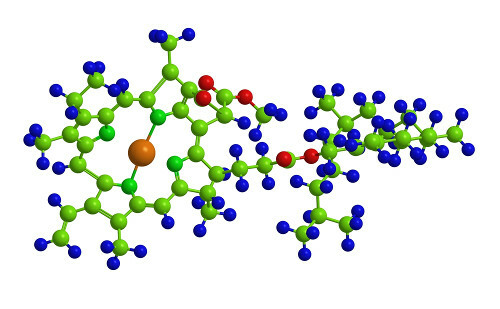THE chlorophyll (from the Greek: chloros, green + phyllon, leaf) is a pigment found in plants, seaweed and some bacteria which presents as its most striking feature green coloring. Chlorophyll absorbs light in violet, blue and red light lengths and therefore reflects green light. Therefore, plants that have chlorophyll are greenish in color.
THE chlorophyll it is the pigment responsible for capturing light and ensuring that photosynthetic organisms are able to produce their food through the process of photosynthesis. Therefore, it is essential for maintaining the oxygen available on the planet. It is noteworthy that, in addition, this pigment has commercial importance, being used, for example, as antioxidant and coloring in foods.
→ Chlorophyll structure
Chlorophyll is a molecule belonging to the class of porphyrins. It stands out for the presence of four pyrrolic rings and an isocyclic ring, which are linked together by methylene bridges. Inside the molecule, there is a magnesium atom coordinated to the rings.

The figure above represents the structure of chlorophyll a, an important pigment in photosynthesis.
→ Types of chlorophyll
Do not stop now... There's more after the advertising ;)
Chlorophyll is a group of pigments found in different species of organisms. There are three basic types of chlorophyll: chlorophyll a, b and c, in addition to bacteriochlorophyll and chlorobium chlorophyll. Here are some of the main characteristics of these chlorophylls:
Chlorophyll a: This type of chlorophyll is present in cyanobacteria and in all eukaryotes capable of photosynthesis. It is formed by a magnesium ion attached to a nitrogen-containing porphine ring to which a hydrocarbon chain is attached. In vegetables, this pigment represents 75% of the pigments present.
Chlorophyll b: This chlorophyll is present in plants, algae belonging to the group of euglenophytes and green algae. Unlike chlorophyll a, chlorophyll b acts as an accessory pigment in photosynthesis, ensuring a broadening of the range of light that can be used in this process.
Chlorophyll c: This chlorophyll is found in brown algae and diatoms. It acts as a substitute for chlorophyll b.
Bacteriochlorophyll: Pigment found in purple bacteria.
Chlorophyll chlorobium: Pigment found in green sulfur bacteria.
CURIOSITY: The term chlorophyll was proposed in 1818 by Pelletier and Caventou to name the green colored substance that comes out of leaves after treatment with alcohol.
By Ma. Vanessa dos Santos
Would you like to reference this text in a school or academic work? Look:
SANTOS, Vanessa Sardinha dos. "What is chlorophyll?"; Brazil School. Available in: https://brasilescola.uol.com.br/o-que-e/biologia/o-que-e-clorofila.htm. Accessed on June 28, 2021.


